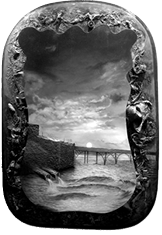By Dorothy A. Wilson
Committed to showcasing art that mirrors life in the 21st century, the nonprofit FusionArts Museum has spent two decades promoting ‘fusion art’ as a genre of its own. This wild, lesser-known form is defined, according to museum director Deborah Fries, by “constant chaos, multi-sensory bombardment and ever-advancing technology.” She likens fusion art to “an assemblage on steroids.”
Currently on display are two new solo exhibitions by Shalom Tomas Neuman entitled “Toxic Paradise” and “Amerika.” Fully operational and frequently electronic, the artworks in both series are the very definition of fusion art—a philosophy, asserts Neuman, “for all the senses, with infinite variation.”
In “Toxic Paradise,” a timely collection about the worldwide ecological disaster, Neuman takes large cleverly constructed pieces of plywood and ‘infuses’ the ‘shrines’ with found objects, computerized lighting, sound effects and household appliances. You hear birds chirping and ambient audio. Oil paint on gesso and ‘classically’ sculptured landscapes ‘broadcast’ additional artistic messages to our multiple senses. Each piece has a striking, atmospheric background, with lovely, green pastures, Claritin-clear blue skies or painterly clouds; several ‘environments’ have gorgeous red and purple streaked sunsets.
Seamlessly blended into what at first appears to be a pretty picture is negativity and noise, inhumanity and acid rain. Deforestation, oil pollution, color-coordinated trash. Artificial everything. It’s a tragic world, where not even cartoon characters and pop culture superheroes can help. Semantically, it is truly a fusion of many the medium. Roads lead to nowhere in “Foliage,” where there is none. “Bridge Over Troubled Waters” is crimson and killer. Superman, Spiderman, Popeye, and the Hulk monopolize “Ikon Sandwich,” and “Decorous Detritus” is depressing. Moreover, the dark yet brilliant works in ‘Toxic Paradise” were created between 1984 and 1989, way before the current, popular green movement; and several pieces have gloomy, bent-over pairs of looming towers. The entire collection is emotionally and technologically overwhelming.
And still engaging. Fusion art is able to climb tall buildings without turning its back on conventional, academically accepted art disciplines. Fusion art, Neuman asserts, is the “interdisciplinary integration of all artistic mediums that melds or ‘fuses’ the various genres.” Noted art critic Donald Kuspit writes that the ‘fusion’ artist is an “unprecedented phenomenon: multi-talented, a brilliant draughtsman and virtuoso painter. What looks chaotic is subliminally cohesive.”
In Neuman’s radically cohesive “Amerika,” which is a series of ‘multi-dimensional’ masks about people, each individual has a voice of their own, several in fact—just push the button(s), they speak. Made out of modeling paste, big heads and tiny humans, these vibrant, acrylic and often annoying ‘Amerikans’ are “less portraits than archetypes” (and are) “composites of much of the weirdness that the artist encounters in the human beings who hang out around the vicinity of his studio in Brooklyn,” says critic Robert C. Morgan.
An award-winning artist, scholar and pioneer in the fusion art movement, Neuman is also the last surviving male of a large Jewish family, most of whom were killed by the Nazis during the Holocaust. Born in Prague, he and his family left Czechoslovakia towards the end of the war and moved to Israel, where he spent his childhood. When Shalom was 12, they immigrated to Pittsburgh; New York has been his home since the early eighties.
FusionArts Museum is on the Lower East Side, a neighborhood presently undergoing an ugly transformation/fusion itself, one marred by high-rises, a big, new museum and several parasitic galleries from ‘uptown.’ The permanent collection includes two rambunctious, 15-foot robots, as well as a large Renaissance style triptych entitled “Classical Myth.” In this sumptuous oil painting reminiscent of ‘Vermeer meets Dali,’ a black male nude and a white bare-breasted female pose amid a surreal 3D potted plant and a Christ-like child figure. Though it may not be suitable for all ages/sensitivities, like Neuman’s new exhibitions, it’s a magnificent example of fusion art.


































